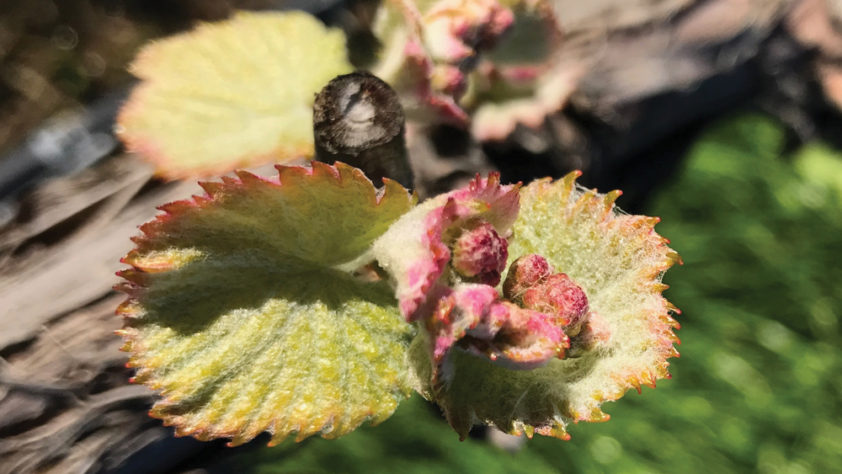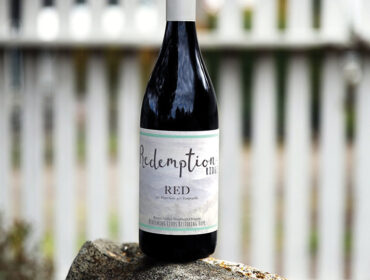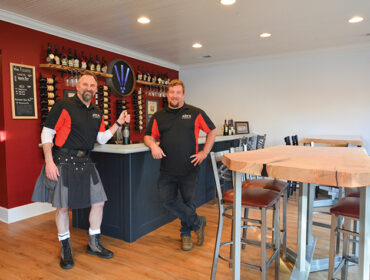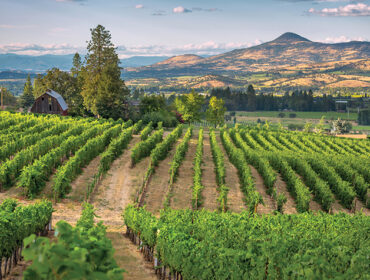
A Year in the Life: Bud Break to Veraison – by MJ Daspit
Spring is marked in wine country by the emergence of leaves on the vines at bud break. Until the end of May, the threat of frost lingers, but as the days warm and lengthen, the pulse of the winemaker quickens with anticipation of a new vintage, and tasting rooms get a rush of summer visitors. Wine Scene talks to Dick and Pat Ellis of Pebblestone Cellars and Ellis Vineyard; Kate Vangeloff of LongSword Vineyard; and Aga Paschal and Rene Eichmann of Paschal Winery and Vineyard to find out what’s happening as they wait for the grapes to ripen.
Vangeloff notes that bud break occurred in mid-April at her Applegate Valley site. “Since then we’ve been shoot-thinning the canopy to avoid powdery mildew issues and to promote the ripening of the fruit. It’s also time to start de-suckering, getting rid of the little shoots that grow up from the ground. It’s an exciting time because we’re worried about frost—up until Memorial Day weekend there’s still a little chance.”
At his vineyard in Medford, Ellis monitors the weather closely. “Just after May 1st we could tell from the weather outlook and the history that we were probably past any threat of frost so we’ve been going through all the vines performing final pruning and clean-up. Our next goal, as the vines begin the ‘grand growth’ phase, is to begin to train all the remaining shoots up through the three sets of catch wires. After we get the vines trained, then we will watch for bloom and then crop set. Once we get to crop set we will be able to estimate and adjust our crop load. We will then begin putting managed stress on the vines through our irrigation practices. This allows us to limit berry size in red grapes by limiting growth. This also limits canopy growth and focuses the plant’s energy on getting that fruit ripe. Of course we’re always on the lookout during this period for any kind of bugs we might have to deal with.”
Looking ahead to veraison, when the grapes lose their green color and transition to golden for whites and purple for reds, Ellis tries to anticipate how this year is shaping up by referring to graphs of temperature data on his vineyard going back fifteen years. “Our warmest year was 2015 with almost 3200 degree days of heat accumulation. Our coolest year was 2010 at around 2400 degree days. The cool years correlate to La Niña conditions and the warmer years to El Niño.” During cooler years he will adjust the crop load down to allow the vines to ripen their grapes with less heat. When the data indicates a warmer year he maintains his crop load at a normal to slightly heavier production level.
Eichmann, who manages Aga Paschal’s vineyards near Talent, says he’ll likely drop fruit at about 50%-75% veraison, cutting off any clusters that are still completely green. This year, he’s paying particular attention to a new block of Cabernet Sauvignon and Malbec. “We expanded the vineyard in 2017 by four additional acres. With these young plants I used the European method and trained the plants to establish a trunk in the first year. The American standard is you put the plant in and let it grow wild for one year to establish a root system. I feel you can also establish a trunk if the plants are strong enough and have enough nutrients. I want to say 80% of our new vines made a trunk, so we’ll actually get some grapes out of these plants in the second year.”
Aga Paschal points to the original vineyard blocks planted in the late 80’s. “In 1998 we started production on the site which would make this year our 20th anniversary.”
Eichmann suggests, “Let’s have a party.”
Paschal laughs, noting a number of events already scheduled. “We’ve always been a community center, more or less. We try to give people what they want, like music. The Classical Guitar Society approached us, so we created a monthly event for them. We also have jazz on a regular basis. We started hosting local restaurants with the famous Cork and Fork series every Wednesday, no exceptions—unless it’s Christmas. We also do our wine club parties four times a year with a complimentary buffet and glass of wine for all members. Rene is here chatting with everyone, of course.”
At the Pebblestone tasting room, new last year, Bear Creek passport events have begun. “It’s helped a lot for us to have the larger space here. It has allowed us to have music inside in the winter when it’s cold. Now we’re starting to transition outside.” Ellis points to the area beyond the patio where there will soon be a new lawn and a stage for musicians.
Vangeloff is ramping up for June, LongSword’s busiest month in the tasting room. “It’s the biggest tourist time, before it gets too hot, when you get the beautiful spring into summer. I’m making sure the tasting room is 100% ready to go, well staffed, well stocked—hopefully with wine!” She smiles, alluding to the fact that the inventory keeps selling out.
She’s also gearing up for a kite festival and the new Applegate Open International Paragliding Competition. “It’s windy at LongSword as it gets later in the afternoon and evening, which is great for the vines. It kind of clears everything out. When I first got here I was trying to come up with events and then I thought, wind, kites—duh.” The paragliding event, previously called the Rat Race, historically attracts 150-200 pilots from all over the world. “Last year the couple who had produced it for the last fifteen years announced that they were done, so we decided to pair up with the local paragliding club and stage our own competition.”
In the LongSword winery, Vangeloff and her uncle Matt Sorensen are “dancing around trying to make space for everything. There’s an amazing amount of figuring out what will fit in what containers. We’re running out of bottled wine going into the high season, so we need to get some wine in the bottle and labels on. We do it all ourselves. Basically either Matt or I have corked every bottle.”
Pebblestone wines are vinified at Naumes Custom Crush & Fermentation under winemaker Chris Graves. “We just finished bottling,” Ellis says. “That involves a lot of the time tasting the wines and getting them perfectly balanced. With the reds I personally manage our barrel program—what wines get what barrels and how much time in barrel. We may make anywhere from four to twelve barrels of wine of a specific varietal. Different wines need different oak treatments. I have a huge matrix on that because we’ve got 70 barrels and two vintages going at any one time.”
Eichmann enjoys making Paschal wines at the Bridgeview Winery in Cave Junction. “Bridgeview has never had a high profile tasting room or a wine club. So making Paschal wines gives me more of a creative outlet to make artisanal wines. It’s a great way for me to do some really amazing reds, some nice blends and get feedback from people in the tasting room. My take on winemaking has always been that we’re trying to make wine for our customers not for ourselves.” With his typical sense of humor he adds, “Aga and I can only drink so much wine.”
After veraison it’s not long before the grapes achieve the right level of sugar and phenolic character that signals they are ready to pick. Stay tuned for our next installment of “A Year in the Life” when Wine Scene will talk to another group of wine industry professionals to get the low down on what goes on in the vineyard, the winery and the tasting room with the climax of harvest.
©Southern Oregon Wine Scene – from Spring 2019 issue
Related Post
RoxyAnn Winery–Making a Difference with Redemption...
Update to this article on 07/29/21 – “… the Board of Directors of Redemption Ridge have made the difficult decision to clo...
Awen Winecraft: An Inspirational New Reason...
As if you needed another reason to visit historic Jacksonville, now there’s another draw—Awen Winecraft’s new tasting room located at ...
Rogue Valley Rising – by Valerie...
MEDFORD, OREGON’S star is rising on the world stage as it rapidly becomes a top destination for connoisseurs of fine wine and for enthusia...




